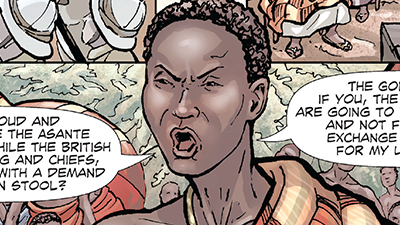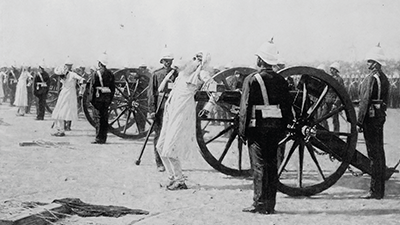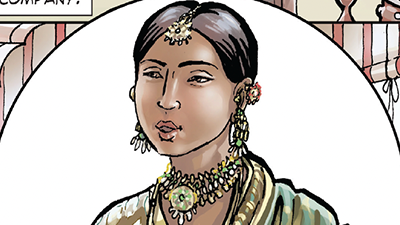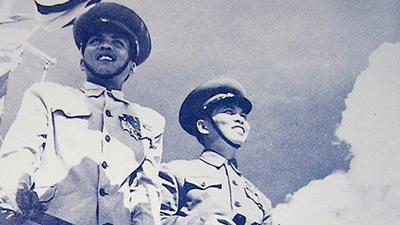Resisting Colonialism
Driving Question: How did colonized people resist colonial control?
Empires used a variety of strategies to enforce their rule and expand their reach. Still, everywhere they expanded, empires met resistance. Colonized people resisted in many ways, from violent revolt to quieter, everyday forms of noncompliance.
Learning Objectives:
- Use evidence to examine the different direct and indirect strategies used to resist colonialism.
- Use the historical thinking practices of claim testing and CCOT to evaluate imperialism and the changes and continuities from the first global age to the long nineteenth century.
- Use a graphic biography to support, extend, or challenge the overarching narratives of this period.
Vocab Terms:
- collaborate
- dissent
- humiliation
- mutiny
- resistance
- treaty
- uprising
Opener: Resisting Colonialism
To teach this lesson step, refer to page 2 of the Lesson 7.10 Teaching Guide.
Our Openers and Closers Guide provides more information about these short, but important activities at the beginning and end of each lesson.
As you prepare to learn about the ways that colonized people resisted, sort the thinking of imperialism into motives and goals.
Resistance in Ghana
To teach this lesson step, refer to page 3 of the Lesson 7.10 Teaching Guide.
For more about our historical comics, check out the Graphic Biographies Guide.
Learn how Ghanaians challenged colonial rule through everyday resistance and bold leadership. These materials highlight powerful actions taken by individuals and communities to defend their land and dignity.
-
Guiding Questions
-
Before you watch
Preview the questions below, and then review the transcript.
While you watch
Look for answers to these questions:
- When did the British conquer the area that is now Ghana?
- What was the Customs House used for under British rule?
- How did some Ghanaians resist while working at the Customs House?
- What kind of transportation did the British use to control cocoa exports?
- Why was the trotro system important for Ghanaians under colonial rule?
After you watch
Respond to this question: How did the resistance shown in this video challenge your ideas about what colonialism looked like?
Key Ideas
-
Guiding Questions
-
Before you read
Preview the questions below, and then skim the comic, paying attention to things like prominent colors, shapes, and types of text and fonts. How do you know where to start and in which direction to read? What’s in the gutters (the space between panels)? Who or what is the focus of the comic?
While you read
- What was the Asante state, and who was Yaa Asantewaa?
- What role did the Queen Mother, or Ohemaa, play in Asante society?
- What happened in 1895, and how did it shape Yaa Asantewaa’s actions?
- What events unfolded in 1900, and how did Yaa Asantewaa respond?
- How does the artwork in this biography represent Yaa Asantewaa’s leadership?
After you read
Respond to this question: How does this biography of Yaa Asantewaa support, extend, or challenge what you've learned about resistance to colonial rule in this period?
Resistance in India
To teach this lesson step, refer to page 4 of the Lesson 7.10 Teaching Guide.
For reading strategies check out the OER Project Reading Overview.
Learn what sparked the 1857 Indian Uprising and how Indian people challenged British colonial rule. This article and comic highlight the pivotal roles individuals played in challenging colonial rule.
-
Guiding Questions
-
Before you read
Preview the questions below, and then skim the article. Be sure to look at the section headings and any images.
While you read
Look for answers to these questions:
- Who controlled most of India in 1857?
- What was the doctrine of lapse?
- Who served in the East India Company’s army?
- How were Indian soldiers in the Company’s army treated?
- What caused the 1857 uprising, and what was its outcome?
After you read
Respond to this question: Why do the words we use—such as mutiny, revolt, or war of independence—shape how we understand the 1857 uprising?
-
Guiding Questions
-
Before you read
Preview the questions below, and then skim the comic, paying attention to things like prominent colors, shapes, and types of text and fonts. How do you know where to start and in which direction to read? What’s in the gutters (the space between panels)? Who or what is the focus of the comic?
While you read
- Where did Azizun live, and what was the political status of that place in 1856?
- What was a Tawa’if, and how did the British view them?
- How did Azizun respond to the events of 1856 and 1857?
- In what ways did Azizun defy expectations for women at the time?
- What message does the final image send about Azizun’s resistance?
After you read
Respond to this question: How does Azizun’s story support or challenge what you’ve learned about the “civilizing mission” and resistance to colonial rule?
Summarizing Resistance
To teach this lesson step, refer to page 6 of the Lesson 7.10 Teaching Guide.
Watch this Claim Testing video for an overview of how to support students in learning this skill.
How did people resist colonial rule? With these materials, you’ll read about creative forms of resistance across Southeast Asia, and then test claims about imperialism using real-world examples.
-
Guiding Questions
-
Before you read
Preview the questions below, and then skim the article. Be sure to look at the section headings and any images.
While you read
Look for answers to these questions:
- How were crops like corn and cassava used as tools of resistance?
- What were some goals colonial subjects hoped to achieve through resistance?
- How did rats become part of resistance efforts in Hanoi?
- In what ways did French education in Indochina backfire?
- How did people in the Southeast Asian highlands avoid colonial control?
After you read
Respond to this question: How did these examples challenge your understanding of what resistance can look like?
Continuity and Change Over Time
To teach this lesson step, refer to page 11 of the Lesson 7.10 Teaching Guide.
It’s hard to improve without feedback. Check on your student’s CCOT progress using the CCOT: Feedback Form.
Industrialization didn’t erase the past—it built on it. In this part of the lesson, you’ll look back at global trends from 1200 to 1914 to identify what changed and what stayed the same. Then, you’ll decide which developments mattered most and how they shaped the modern world.
Closer: Resisting Colonialism
To teach this lesson step, refer to page 15 of the Lesson 7.10 Teaching Guide.
The OER Project Writing Guide emphasizes the importance of informal writing in the course.
In this unit, you explored how industrialization reshaped the world. Now, use what you’ve learned to reflect on how it changed global power and sparked new movements for change.








